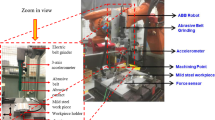Abstract
Predicting chatter stability in a micro-milling operation is challenging since the experimental identification of the tool-tip dynamics is a complicated task. In micro-milling operations, in-process chatter monitoring strategies can use acoustic emission signals, which present an expressive rise during unstable cutting. Several authors propose different time and frequency domain metrics for chatter detection during micro-milling operations. Nevertheless, some of them cannot be exploited during cutting since they require long acquisition periods. This work proposes an in-process chatter detection method for micro-milling operation. A sliding window algorithm is responsible for extracting datasets from the acoustic emissions using optimal window and step packet sizes. Nine statistical-based features are derived from these datasets and used during training/testing phases of machine-learning classifiers. Once trained, machine learning classifiers can be used in-process chatter detection. The results assessed the trade-off between the number of features and the complexity of the classifier. On the one hand, a Perceptron-based classifier converged when trained and tested with the complete set of features. On the other hand, a support vector classifier achieved good accuracy values, false positive and negative rates, considering the two most relevant features. A classifier’s output is derived at every step; therefore, both proposals are suitable for in-process chatter detection.













Similar content being viewed by others
References
Park SS, Rahnama R (2010) Robust chatter stability in micro-milling operations. CIRP Ann 59(1):391–394. https://doi.org/10.1016/j.cirp.2010.03.023
Afazov SM, Ratchev SM, Segal J, Popov AA (2012) Chatter modelling in micro-milling by considering process nonlinearities. Int J Mach Tools Manuf 56:28–38. https://doi.org/10.1016/j.ijmachtools.2011.12.010
Jin X, Altintas Y (2013) Chatter stability model of micro-milling with process damping. J Manuf Sci Eng 135(3). https://doi.org/10.1115/1.4024038
Lu X, Jia Z, Liu S, Yang K, Feng Y, Liang SY (2019) Chatter stability of micro-milling by considering the centrifugal force and gyroscopic effect of the spindle. J Manuf Sci Eng 141(11). https://doi.org/10.1115/1.4044520
Graham E, Mehrpouya M, Nagamune R, Park SS (2014) Robust prediction of chatter stability in micro milling comparing edge theorem and LMI. CIRP J Manuf Sci Technol 7(1):29–39. https://doi.org/10.1016/j.cirpj.2013.09.002
Mamedov A (2021) Micro milling process modeling: a review. Manag Rev 8:3. https://doi.org/10.1051/mfreview/2021003
Chen Y, Li H, Jing X, Hou L, Bu X (2019) Intelligent chatter detection using image features and support vector machine. Int J Adv Manuf Technol 102(5–8):1433–1442. https://doi.org/10.1007/s00170-018-3190-4
Shi Y, Mahr F, von Wagner U, Uhlmann E (2012) Chatter frequencies of micromilling processes: Influencing factors and online detection via piezoactuators. Int J Mach Tools Manuf 56:10–16. https://doi.org/10.1016/j.ijmachtools.2011.12.001
Li H, Jing X, Wang J (2014) Detection and analysis of chatter occurrence in micro-milling process. Proc Inst Mech Eng B J Eng Manuf 228(11):1359–1371. https://doi.org/10.1177/0954405414522216
Yuan Y, Jing X, Li H, Ehmann KF, Zhang D (2018) Chatter detection based on wavelet coherence functions in micro-end-milling processes. Proc Inst Mech Eng B J Eng Manuf 233(9):1934–1945. https://doi.org/10.1177/0954405418808214
Inasaki I (1998) Application of acoustic emission sensor for monitoring machining processes. Ultrasonics 36(1–5):273–281. https://doi.org/10.1016/s0041-624x(97)00052-8
Ribeiro KSB, Venter GS, Rodrigues AR (2020) Experimental correlation between acoustic emission and stability in micromilling of different grain-sized materials. Int J Adv Manuf Technol 109(7–8):2173–2187. https://doi.org/10.1007/s00170-020-05711-1
Sio-Sever A, Leal-Muñoz E, Lopez-Navarro JM, Alzugaray-Franz R, Vizan-Idoipe A, de Arcas-Castro G (2020) Non-invasive estimation of machining parameters during end-milling operations based on acoustic emission. Sensors 20(18):5326. https://doi.org/10.3390/s20185326
Filippov AV, Rubtsov VE, Tarasov SY, Podgornykh OA, Shamarin NN (2017) Detecting transition to chatter mode in peakless tool turning by monitoring vibration and acoustic emission signals. Int J Adv Manuf Technol 95(1–4):157–169. https://doi.org/10.1007/s00170-017-1188-y
Li M, Huang D, Yang X (2021) Chatter stability prediction and detection during high-speed robotic milling process based on acoustic emission technique. Int J Adv Manuf Technol 117(5–6):1589–1599. https://doi.org/10.1007/s00170-021-07844-3
Wang R, Song Q, Liu Z, Ma H, Gupta MK, Liu Z (2021) A novel unsupervised machine learning-based method for chatter detection in the milling of thin-walled parts. Sensors 21(17):5779. https://doi.org/10.3390/s21175779
Wang X, Lu X, Jia Z, Jia X, Li G, Wu W (2013) Research on the prediction model of micro-milling surface roughness. Int J Nanomanuf 9(5/6):457. https://doi.org/10.1504/ijnm.2013.057595
Elizondo D (2006) The linear separability problem: some testing methods. IEEE Trans Neural Networks 17(2):330–344. https://doi.org/10.1109/tnn.2005.860871
Wang L (2005) Support vector machines: theory and applications. Studies in fuzziness and soft computing. Springer, Berlin Heidelberg. https://books.google.com.br/books?id=UVd7CwAAQBAJ
Christmann A, Steinwart I (2008) Support vector machines. Springer, New York. https://doi.org/10.1007/978-0-387-77242-4
Batista OE, Flauzino RA, de Araujo MA, de Moraes LA, da Silva IN (2016) Methodology for information extraction from oscillograms and its application for high-impedance faults analysis. Int J Electr Power Energy Syst 76:23–34. https://doi.org/10.1016/j.ijepes.2015.09.019
Funding
This study was financed in part by the Coordenação de Aperfeiçoamento de Pessoal de Nível Superior - Brasil (CAPES) - Finance Code 001. Also, the authors would like to thank the Brazilian funding agencies: CNPq 303884/2021-5, and FAPESP 2019/00343-1.
Author information
Authors and Affiliations
Contributions
All authors contributed to the study’s conception and design. Kandice Ribeiro, Giuliana Venter, and Alessandro Roger Rodrigues performed material preparation and data collection. Guilherme Serpa Sestito performed conceptualization of this study, methodology, and software. Maíra Martins da Silva also worked on conceptualizing this study and data curation. The first draft of the manuscript was written by Guilherme Serpa Sestito and Maíra Martins da Silva, and all authors commented on previous versions of the manuscript. Finally, all authors read and approved the final manuscript.
Corresponding author
Ethics declarations
Conflicts of interest
The authors declare that they have no conflict of interest.
Additional information
Publisher’s Note
Springer Nature remains neutral with regard to jurisdictional claims in published maps and institutional affiliations.
Rights and permissions
About this article
Cite this article
Sestito, G.S., Venter, G.S., Ribeiro, K.S.B. et al. In-process chatter detection in micro-milling using acoustic emission via machine learning classifiers. Int J Adv Manuf Technol 120, 7293–7303 (2022). https://doi.org/10.1007/s00170-022-09209-w
Received:
Accepted:
Published:
Issue Date:
DOI: https://doi.org/10.1007/s00170-022-09209-w




